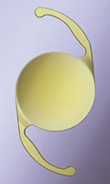Premium lens options
Artificial intraocular lenses, or IOLs, replace the eyes natural lens that is removed during cataract surgery. IOLs have been around since the mid-1960s, though the first FDA approval for one occurred in 1981. Before that, if you had cataracts removed, you had to wear very thick eyeglasses or special contact lenses in order to see afterward, since the natural lens that had been removed wasnt replaced with an artificial one. Until recently, only cataract surgeons not their patients weighed the risks and benefits of various IOLs. But now that new IOLs have been introduced that solve more vision problems than ever, cataract surgeons have more to consider before choosing IOLs for their patients visual needs. Cataract patients are becoming more involved in the choice as well.
If you or someone you know will be undergoing cataract surgery, talk to one of our ophthalmologists at Berkshire Eye Center about what IOL may be best for you.
Please consider your choices in the following summary of the most recently developed IOLs.
Premium IOLs: Multifocal & Accommodating
Traditional IOLs are monofocal, meaning they offer vision at one distance only (far, intermediate or near). They definitely are an improvement over the cataractous lens that is replaced during surgery, which provides only cloudy, blurred vision at any distance. But traditional IOLs mean that you must wear eyeglasses or contact lenses in order to read, use a computer or view objects at arms length.
The new multifocal and accommodating IOLs offer the possibility of seeing well at more than one distance, without glasses or contacts. Examples of multifocal/accomodative IOLs include Alcons ReSTOR, Abbott Medical Optics Tecnis multifocal lenses, and Bauch & Lombs Crystalens. One major downside to multifocal IOLs is that a small percentage of patients experience glare and halos at night.
Presbyopia-correcting IOLs are considered premium lenses, which means that you must pay any associated extra cataract surgery costs yourself. Medicare and most health care plans will not cover these extra costs, because the additional benefits of these IOLs are considered a luxury and not a medical necessity.

Toric IOLs for Astigmatism
Toric IOLs designed to correct astigmatism also are considered premium lenses, and like multifocal and accommodating IOLs likely will cost you extra because of benefits that are unavailable in conventional IOLs.
Alcons AcrySof IQ Toric IOL is an astigmatism-correcting premium intraocular lens. The FDA approved the AcrySof IQ Toric IOL in September 2005. Different models of this toric IOL can correct 1.50 to 4.00D or more of astigmatism. Astigmatism can be corrected with a toric IOL safely and reliably. As with any surgery there are risks. Risks particular to toric IOLs include poor vision due to the lens rotating out of position, with the possibility of further surgery to reposition or replace the IOL.
Monovision With Intraocular Lenses
If your cataract surgery involves both eyes, you might want to consider monovision. This involves implanting an IOL in one eye that provides closer vision and an IOL in the other eye that provides distance vision.
Most people adjust to this, but may still need glasses for certain distances. Your surgeon may suggest a trial-fit of monovision contact lenses prior to inserting monovision IOLs to better determine if monovision would be a good option for you. One disadvantage to monovision is that depth perception may decrease because there is less binocular vision meaning, your eyes aren't working together as they once did. Not everyone experiences the loss of depth perception.
People who do best with monovision are patients already accustomed to monovision with contact lenses, which is a common way of correcting presbyopia. Some people who have failed a trial with monovision contact lenses often succeed when monovision is achieved with intraocular lens implants. Mixing multifocal lenses is another method of achieving a type of modified or blended monovision by using one type of IOL that emphasizes distance vision and another that emphasizes intermediate vision.
If you would like to find out whether you're a candidate for one of these lenses, call Berkshire Eye Center and schedule an appointment to meet with one of our doctors. Cataract removal/IOL implantation has one of the highest success rates among all surgeries, but it's important to know the risks beforehand. Ask your surgeon to explain any potential problems that your new IOLs could cause.
You'll also need to think about cost. Cataract surgery is covered by Medicaid, Medicare, and virtually all health insurance plans. The costs of traditional IOL implants are fully covered as well, since insurers view these implants as medically necessary.
But costs associated with the newer implants such as Toric, ReSTOR, Tecnis and Crystalens are not fully covered (even if the procedure itself is), because these premium IOLs are more expensive and their special features tend to be viewed by insurers as nice to have but not absolutely necessary.

